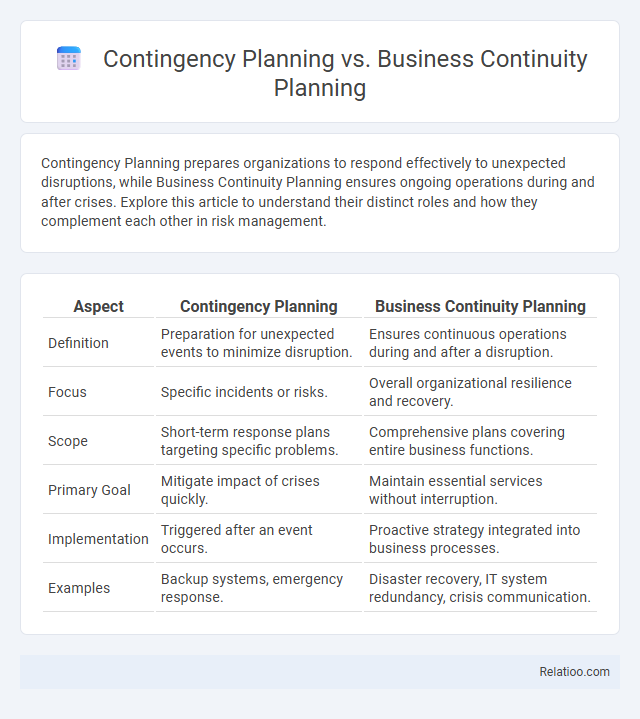Contingency Planning prepares organizations to respond effectively to unexpected disruptions, while Business Continuity Planning ensures ongoing operations during and after crises. Explore this article to understand their distinct roles and how they complement each other in risk management.
Table of Comparison
| Aspect | Contingency Planning | Business Continuity Planning |
|---|---|---|
| Definition | Preparation for unexpected events to minimize disruption. | Ensures continuous operations during and after a disruption. |
| Focus | Specific incidents or risks. | Overall organizational resilience and recovery. |
| Scope | Short-term response plans targeting specific problems. | Comprehensive plans covering entire business functions. |
| Primary Goal | Mitigate impact of crises quickly. | Maintain essential services without interruption. |
| Implementation | Triggered after an event occurs. | Proactive strategy integrated into business processes. |
| Examples | Backup systems, emergency response. | Disaster recovery, IT system redundancy, crisis communication. |
Understanding Contingency Planning
Contingency planning involves preparing specific, actionable strategies to address potential disruptions by identifying risks and outlining detailed response procedures. It focuses on minimizing operational impact through predefined alternatives, ensuring critical functions can continue during unexpected events. This differs from business continuity planning, which encompasses broader processes to maintain overall organizational stability, and crisis management, which emphasizes immediate decision-making and communication during emergencies.
Defining Business Continuity Planning
Business Continuity Planning (BCP) involves creating systems of prevention and recovery to deal with potential threats to an organization, ensuring that critical business functions continue during and after a disaster. Unlike Contingency Planning, which focuses on specific scenarios and immediate responses, BCP encompasses a broader strategy for overall operational resilience. Your organization relies on Business Continuity Planning to minimize downtime and maintain service delivery when unexpected disruptions occur.
Key Objectives of Contingency Planning
Contingency Planning focuses on preparing Your organization for unexpected disruptions by identifying potential risks and developing actionable response strategies to minimize operational impact. Key objectives include ensuring rapid recovery of critical functions, safeguarding essential resources, and maintaining communication channels during emergencies. This proactive approach helps mitigate damage and supports a seamless transition back to normal operations.
Core Goals of Business Continuity Planning
Business Continuity Planning (BCP) focuses on maintaining essential business functions during and after a disruptive event, ensuring minimal downtime and data loss. Unlike Contingency Planning, which prepares specific backup actions for identified risks, BCP encompasses comprehensive strategies for operational resilience across all critical processes. Crisis Management addresses immediate response and communication during emergencies, while BCP aims to sustain long-term operational stability and recovery.
Contingency Planning vs. Business Continuity Planning: Main Differences
Contingency planning focuses on preparing specific responses to potential threats or disruptions, outlining predefined actions to mitigate risks in isolated incidents. Business continuity planning ensures the organization maintains essential functions and operations during and after a disruption by integrating comprehensive recovery strategies across all departments. Your organization benefits from contingency planning's targeted risk mitigation and business continuity planning's holistic approach to sustaining long-term operational resilience.
Overlapping Areas Between Contingency and Continuity Plans
Contingency Planning and Business Continuity Planning both prioritize risk mitigation by preparing organizations to respond effectively to unexpected disruptions, ensuring minimal impact on critical operations. Overlapping areas include establishing backup resources, communication protocols, and recovery procedures to maintain essential functions during crises. Both frameworks emphasize proactive identification of threats and the development of strategies to safeguard data integrity, operational resilience, and stakeholder trust.
Steps to Develop a Contingency Plan
Developing a contingency plan involves identifying critical business functions, assessing potential risks and impacts, and establishing clear response strategies to mitigate disruptions. Key steps include conducting a thorough risk assessment, defining roles and responsibilities, developing communication protocols, and creating detailed action plans to ensure rapid recovery. Regular testing, training, and updating the contingency plan are essential to maintain its effectiveness and alignment with evolving threats and organizational changes.
Creating an Effective Business Continuity Plan
Creating an effective business continuity plan involves identifying critical business functions, conducting risk assessments, and developing strategies to maintain operations during disruptions. Contingency planning focuses on preparing for specific potential risks, while crisis management addresses the response during and immediately after an incident. Integrating these approaches ensures a comprehensive framework that minimizes downtime, protects assets, and supports rapid recovery.
Common Challenges in Contingency and Continuity Planning
Common challenges in contingency and business continuity planning include the accurate identification of critical risks and resources, which directly impact the effectiveness of response strategies. Your organization may face difficulties in maintaining up-to-date plans due to rapidly changing business environments and technological advancements. Another key issue is ensuring employee awareness and training to execute contingency and continuity measures seamlessly during disruptions.
Best Practices for Integrating Both Strategies
Effective integration of Contingency Planning, Business Continuity Planning, and Crisis Management requires a unified framework that aligns risk identification, response protocols, and recovery objectives to ensure minimal disruption and quick restoration of operations. Organizations should develop comprehensive risk assessments that inform both contingency and continuity plans while establishing clear communication channels and decision-making hierarchies for crisis scenarios. Your best approach includes regular cross-training, scenario simulations, and continuous plan updates to maintain resilience and adapt to evolving threats.

Infographic: Contingency Planning vs Business Continuity Planning
 relatioo.com
relatioo.com